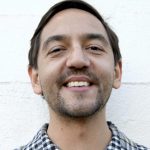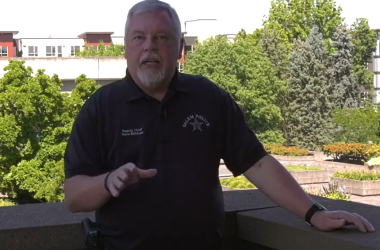With her head deep in a hole at Willamette Heritage Center, Chloe Abrahamson brushed mud off a few ceramic fragments.
Abrahamson, a freshman archaeology major at Willamette University, was part of a group digging at the heritage center Thursday for what they believe could be the foundation of a parsonage building built by Methodist missionaries in 1841.
Her discovery prompted a flurry of activity as Kimberli Fitzgerald, city of Salem archaeologist, rushed over to take a look. She identified the fragments as likely from a plate, made with a type of material available in the 1840s.
The plate could be a vital clue that the parsonage existed at the site.
Fitzgerald runs Salem’s archeological compliance program, which recently received a state award for its ongoing work ensuring the integrity of the city’s archeological sites. On Saturday from 10 a.m. to 4 p.m., there will be an open house to showcase the archeological work underway at the heritage center.
The state award was for the city’s unique approach to preserving local archeological sites by ensuring developers do not disturb or destroy them.
The process includes a roundtable discussion with city officials, the Confederated Tribes of the Grand Ronde, the Confederated Tribes of Siletz Indians, and the Confederated Tribes of Warm Springs when development is proposed on public property or with public money on a known archaeological site.
That process led to significant discoveries several years ago when developers planned an apartment building at 990 Broadway St. N.E. — the original site of the oldest European home in the Pacific Northwest. Archaeological review and excavation before construction uncovered some of the original foundation and 2,000 artifacts.

Fitzgerald said the city’s program was first implemented in 2018, and since then, she said municipalities all over the country have reached out to her for advice on starting programs of their own.
The dig underway at the heritage center is part of a major city project that’s been ongoing for several years.
Fitzgerald said the parsonage was built along with the Oregon Mission Indian Manual Labor Training School, one of the first Indian boarding schools on the West Coast. The site of the school is located on the Willamette University grounds, and archeologists began the search for the school and parsonage in 2022.
A few feet away from Abrahamson’s discovery, Doug Reynolds and Randy Pemberton were getting down and dirty with their hands and heads deep inside a rectangular hole dug into the mud.
The pair are volunteer archaeologists with Oregon Archaeological Society.
Reynolds pointed out a piece of compacted wood believed to be part of the parsonage’s foundation.
“Who doesn’t enjoy digging a hole?” Reynolds said with a grin before getting back to work. “And pushing back the frontier of knowledge.”

Fitzgerald said one of the telltale signs for archaeologists searching for foundations from the era is a flash of pink in the dark clay-like soil.
That’s because the Methodist missionaries, on their way to present-day Salem in the 1840s, would stop in the Hawaiian Islands to resupply. Getting to Oregon meant sailing from the East Coast around the entire South American continent – at the time there were no railroads to access the region.
While in Hawaii, the missionaries would collect pink coral to use for construction purposes before sailing to the mouth of the Columbia River where Astoria is today, and then paddling down to Salem along the Willamette River in canoes.
“It makes it kind of pink, so when we are excavating out, and we are getting some brick, and we see the mortar that is kind of pink, then we know we are in the right place,” Fitzgerald said.
Abrahamson continued working diligently, and said she first wanted to be an archeologist from watching the children’s show “Dinosaur Train”.
“As I got older I realized that…this is a way to unearth a lot of stories and have them retold, if they’ve been forgotten,” Abrahamson said. “This is a way to remember history, and origins, and where we come from.”
Thursday was Abrahamson’s second day at the dig and she got to be present for a number of discoveries, including the ceramic plate.
“We found a lot of construction materials, brick, glass, nails, and some pretty cool ceramic,” Abrahamson said. “And a rock feature. We don’t quite know what it is yet.”
Abrahamson said she plans to volunteer for more digs like the one at the heritage center, and in the future, she hopes to graduate and work as a professional archaeologist in the Pacific Northwest and other regions in the western United States.
Abrahamson’s professor, Scott Pike, who teaches environmental science and archeology at Willamette, was also at the dig Thursday.
Pike said while the current discoveries are exciting and promising, it could take some time to determine for sure if the parsonage has been found. The answers still lie underneath the earth.
“Usually you would expect the wood to be on some kind of stone as a foundation, but it’s not…We will have to see,” Pike said. “Our main question is, ‘Was this structure here?,’ or ‘Where was it here?’ Our colleagues at the Grand Ronde are very interested in the landscape of the site. Not so much the location of the building, per se, but how that building fit in with the landscape from that time.”
Contact reporter Joe Siess: [email protected] or 503-335-7790.
SUPPORT OUR WORK – We depend on subscribers for resources to report on Salem with care and depth, fairness and accuracy. Subscribe today to get our daily newsletters and more. Click I want to subscribe!

Joe Siess is a reporter for Salem Reporter. Joe joined Salem Reporter in 2024 and primarily covers city and county government but loves surprises. Joe previously reported for the Redmond Spokesman, the Bulletin in Bend, Klamath Falls Herald and News and the Malheur Enterprise. He was born in Independence, MO, where the Oregon Trail officially starts, and grew up in the Kansas City area.









